
2021 Triumph Bonnies: Fiercer, Cleaner And Lighter
- Feb 24, 2021
- Views : 6764

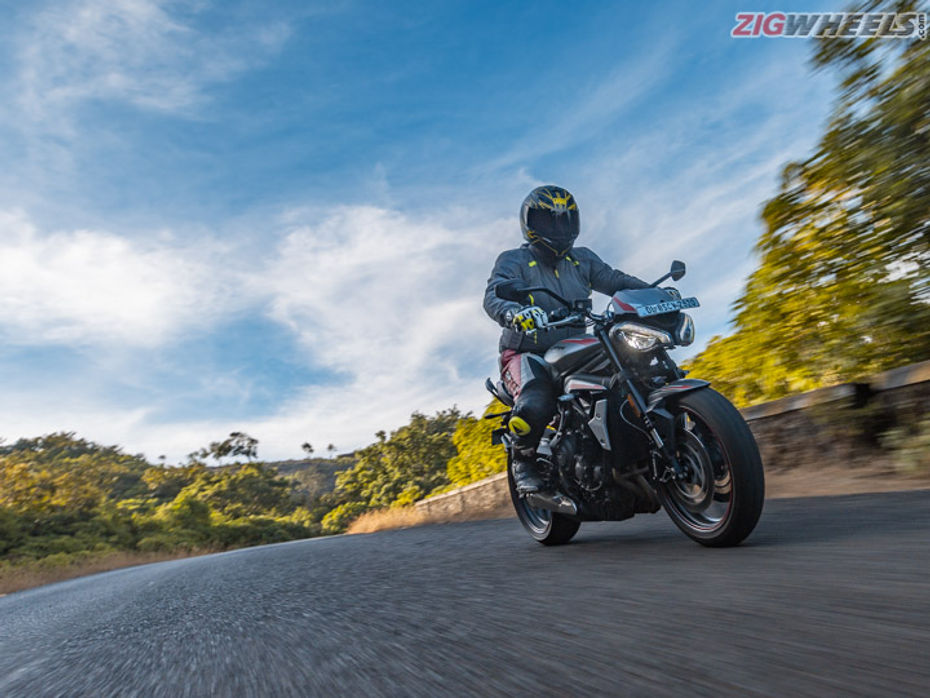
My Street Triple experience so far has been quite polarising. I haven’t had the privilege of riding the old 675, only reading up on its tales of brilliance in foreign publications and hearing from fellow Indian colleagues who got a taste of the bike. The same high praise continued when the first lot of Indian journos sampled the lovely Triumph Street Triple 765 RS in Catalunya in 2017.
So imagine my disappointment when their emotions didn’t exactly make sense to me when I got astride the Street Triple S, the bottom-spec variant in the roadster series. The bike lacked the hallowed Street Triple handling finesse and was a bit bland for my taste, making it seem like a mid-displacement bike on steroids. Cut to a few months later, I got the keys to the Street Triple RS for a couple of days and I finally understood that I should not have held the S to the same high standards because the RS was almost perfect. The ride was every bit as scintillating as I imagined it would be and it was my go-to choice of the segment.
Triumph also made a mid-spec R variant of the Street Triple. It wasn’t as lacking in power as the S and packed nearly the same top-drawer components as the RS, sort of like the perfect balance. It never made it to India. Until 2020, that is. Yes, for the first time, Triumph India brought the Street Triple R to India. It has received nearly the same set of updates that the 2020 RS received (Kartik experienced the bike first hand in Spain, rollicking around the tight Cartagena circuit), and it arrives on our shores with a sticker price of Rs 8.84 lakh (ex-showroom India), that’s Rs 34,000 more than the old Triple S. So that brings us to the important question: is the R a perfect middleground between the S and the RS or is it actually not that far off the RS?
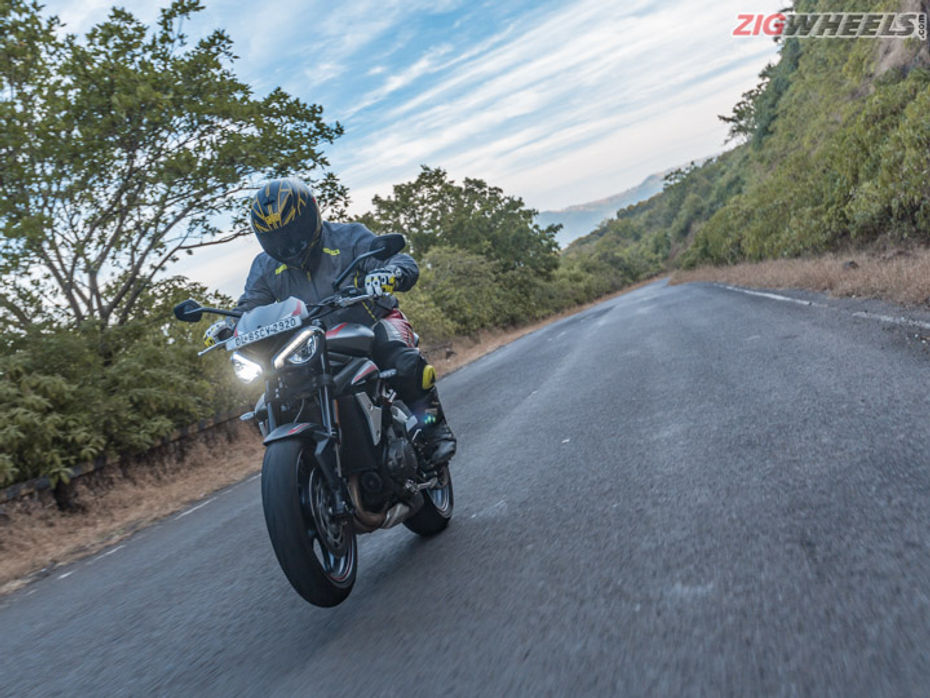
Quick And Versatile
|
Triumph Street Triple R |
Triumph Street Triple RS |
|
|
Specs |
765cc inline-three cylinders, liquid-cooled, DOHC |
|
|
Power |
118PS @ 12,000rpm |
123PS @ 11,750rpm |
|
Torque |
79Nm @ 9,350rpm |
79Nm @ 9,350rpm |
|
Gearbox |
6-speed with slip-and-assist clutch |
|
What’s new with the 765cc triple motor for 2020? Firstly, they gave it better mid-range performance. It used to be a handful to ride both the S as well as the RS in lower revs and higher gears. That isn’t the case any more. It pulls away cleanly from speeds as low as 45kmph in 6th gear. The low-speed tractability of the motor is fantastic, allowing you to commute in fifth or sixth gear quite easily. There’s also none of that low-speed gruffness or shuddering that we experienced earlier and the motor offers a premium experience.
|
Acceleration |
Triumph Street Triple R |
Triumph Street Triple RS BS4 |
|
0-60kmph |
2.14 seconds |
2.22 seconds |
|
0-100kmph |
3.50 seconds |
3.59 seconds |
|
30-70kmph in 3rd gear |
2.40 seconds |
2.63 seconds |
|
40-80kmph in 4th gear |
2.63 seconds |
3.15 seconds |
Even laying down the power is a lot smoother and friendlier than the old RS. It does power wheelie when you want to make a quick getaway from traffic lights but everything feels so controlled and composed. And there’s the bi-directional quickshifter, a standard feature on the R, to quickly shuffle through the six-speed gearbox.
The Street Triple R can cruise at 120kmph with the motor rumbling along at 6,000rpm. While no vibrations are experienced, it almost feels as though the engine is egging you on to ride faster. It wants you to push on, ride a bit faster, make use of all of the 118PS and 12,500-13,000 revs at your disposal.
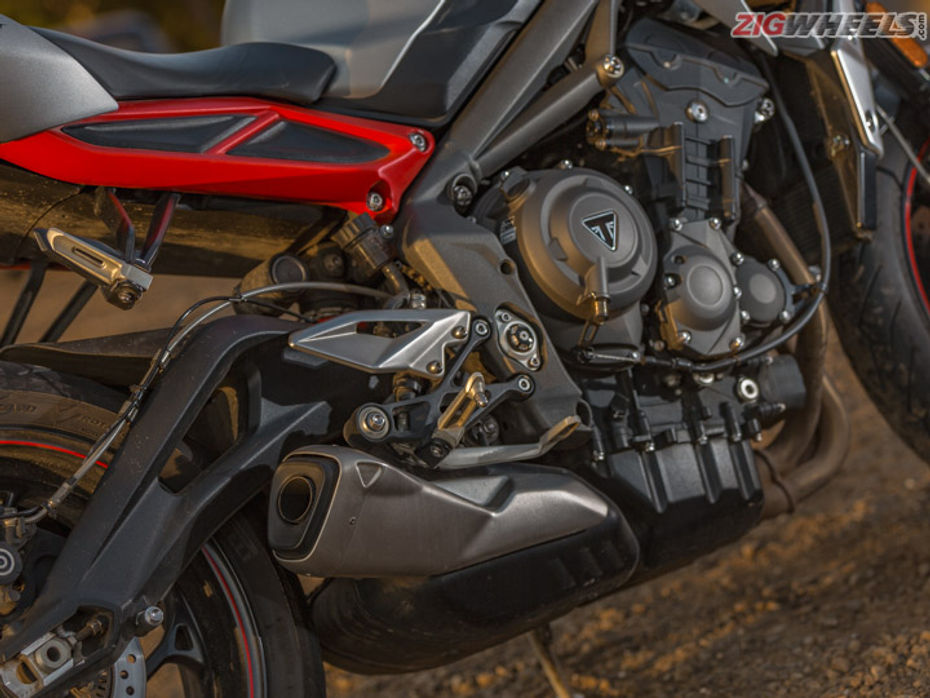
Your Neighbours’ Nightmare
The Bible says, “Love thy neighbour.” However, chances are if you own the Street Triple R, you will not exactly be loved. The three potter mill comes alive in a rather spectacular fashion, burbling quite loudly at low rpms. It turns into a proper ASMR experience as the revs build up, and the engine growls menacingly like a beast. This kind of aural experience is extremely rare with the new emission norms in place.
Now, we had limited time with the bike and couldn’t do a thorough fuel-efficiency test. However, after clocking nearly 130kms of canyon blasting, fast highway cruising and a little bit of commuting, the 765cc engine returned roughly 17kmpl, pretty decent, I say.
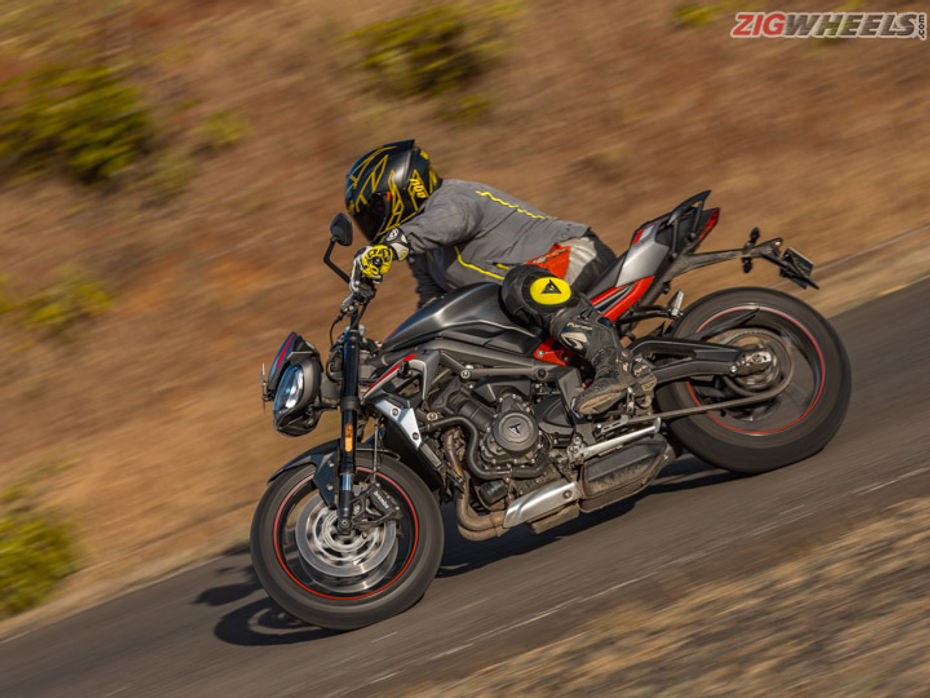
Stick To Sport
The electronic suite on the Triple R isn’t as exhaustive as the one you find on the RS or even on some of its competition. You get four riding modes (Rain, Road, Sport and Rider customisable), each with its own varied traction control and ABS intervention levels. The engine becomes very timid in Rain mode, which is very unlike a Street Triple. For most riders, the Road riding mode would be ideal, as the power delivery is smooth, the engine is dialled to full thrust, and the traction control isn’t too intrusive.
Experienced riders would just keep the fuss to a minimum and stick to Sport. There’s a bit more urgency to the ride, upping the thrill quotient. Traction control barely kicks in and you could even get by with switching off the aid. Triumph has improved the shift quality of the bi-directional quickshifter. It isn’t as slick as the system on a Ducati or an MV Agusta but still, it feels pretty smooth for the most part.
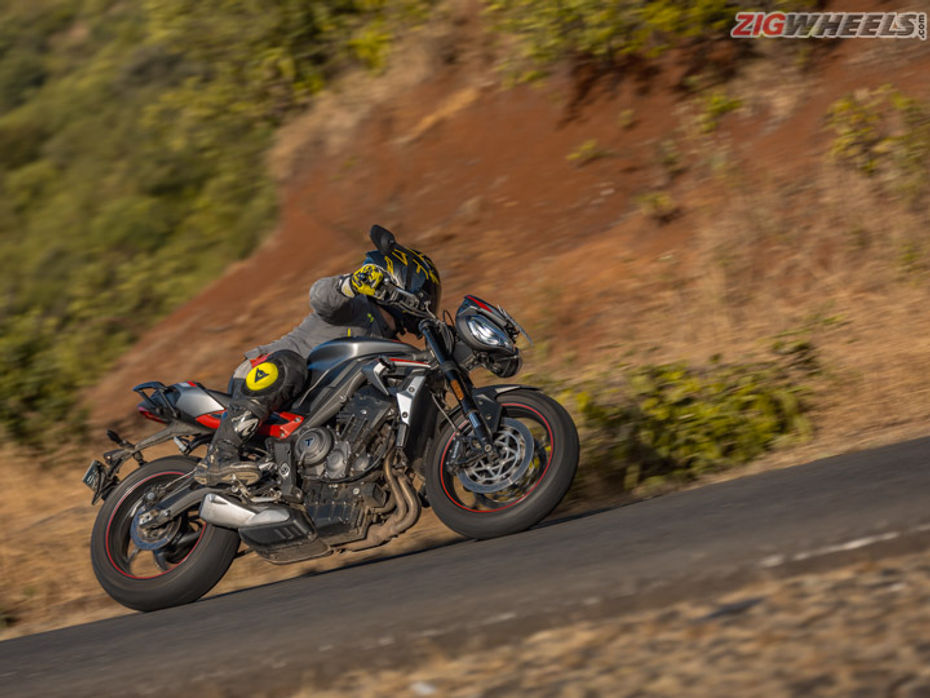
The Lovable School Teacher
Remember the teacher who not only helped you clear all your silly doubts about a particular subject but also made you ace it, with care and affection. That’s what the Street Triple R is: a nice school teacher that will help you learn the basics of cornering on big bikes and make you quite a capable rider while at it.
The Street Triple falls gracefully into a corner, the perimeter frame, compact wheelbase, and sharp steering geometry playing a key role in making it a sublime handler. The steering isn’t freakishly sharp though, rather allowing you to smoothly get into the right line for the corner. Its careful approach also allows you to get away with a mistake once or twice, like coming into a corner a tad too hastily or having to change your line to avoid some road hazard.
It is an incredibly sweet machine. While riding up the fast twisty bits of Lavasa, the Triple R was poised and composed. It did require a bit of effort to switch directions, due to its relatively short handlebar, but none so much to make it a struggle. Even when powering out of corners, the front end rarely comes up, not much corner-exit-wheelieing shenanigans here.
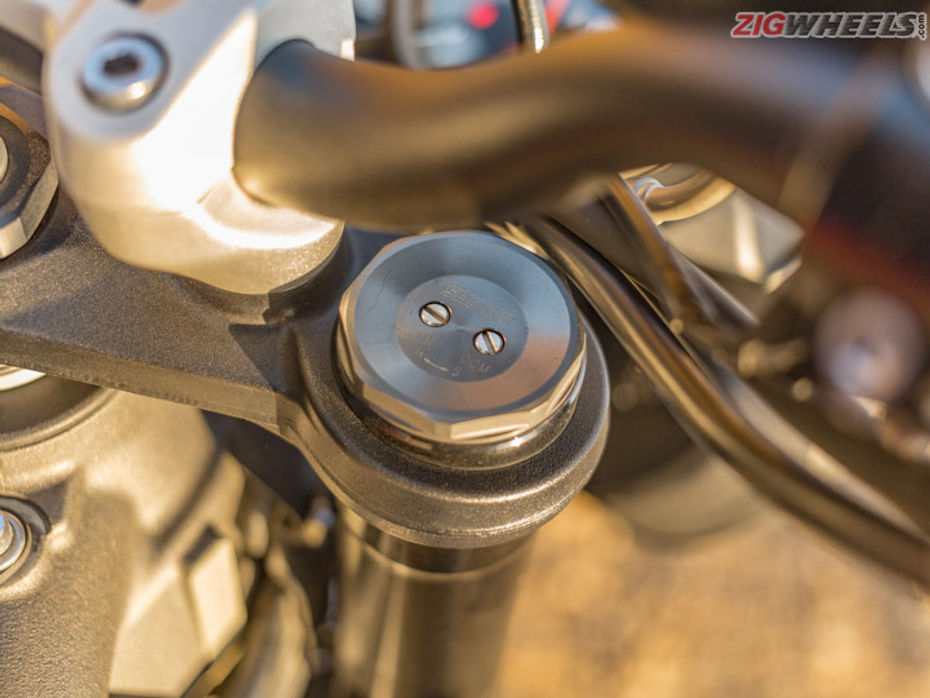
Tuned For India
One of our qualms with the Triple RS was its firm ride quality. The RS’s Showa USD/Ohlins monoshock fully-adjustable suspension bits are tuned to attack corners at a race track, not soak in the unexpected road imperfection that Indian roads love to throw back at you.
In that regard, the R’s Showa USD and monoshock (both also fully-adjustable) arrive with a plush tune. In the real world, the suspension components just devour everything in its path. The Triple R remains planted with no major shocks transmitted back to the rider. It makes light work of city traffic and even though the bars aren’t wide enough to offer you much leverage, you can easily make your way through tight spaces.
If you were worried about grazing the seemingly low cat-con and damaging your prized beauty in the process, you shouldn’t be. Even with 180kg on board (the combined weight of yours truly and an office colleague), it never scraped its belly.
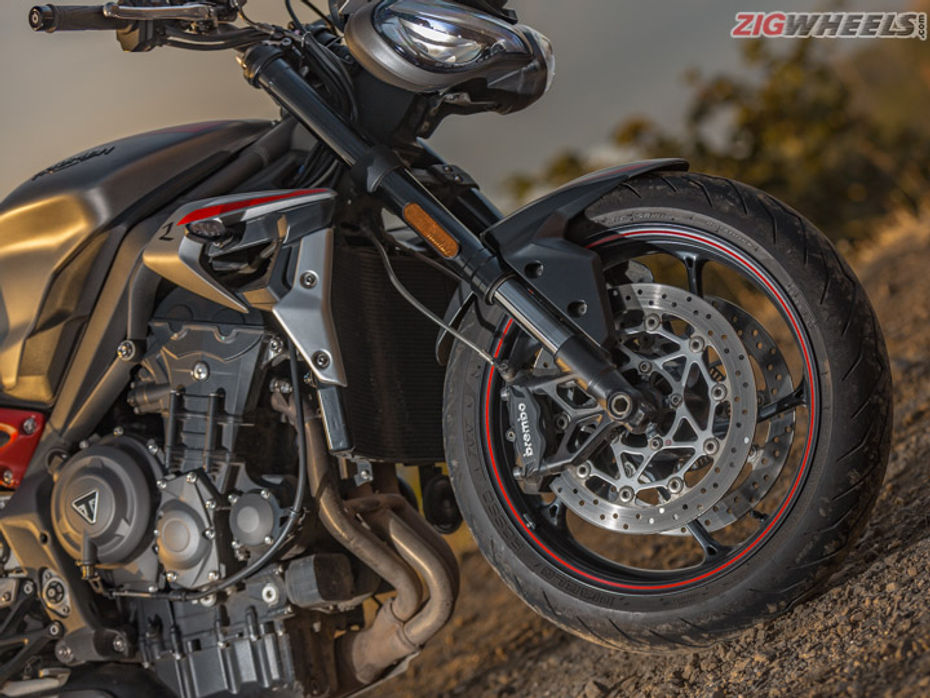
Compromises
|
Acceleration |
Triumph Street Triple R |
Triumph Street Triple RS BS4 |
|
100-0kmph |
43.06m |
42.45m |
|
60-0kmph |
16.03m |
15.95m |
Triumph has not kitted the Triple R with the same braking setup as the RS. So, no Brembo M50 monobloc calipers, Brembo MCS levers and radial master cylinder. You get the entry-level (in the performance-motorcycling world) M4.32 monoblocs and a conventional brake master cylinder. It does shed speed rather quickly, with little to no ABS intervention when going hard on the front brake lever. At the rear, the ABS does kick in subtly. But if you have ridden the RS, the system on the R leaves you longing for a bit more sharpness.
One particularly annoying thing about the brakes is that squeaky noise that is generated when braking from around 40-50kmph. Given that the bike had already clocked over 5,000km, there’s a good chance the noise was a result of heavy wear and tear. However, after inquiring about the same from a biker buddy of mine who has also purchased the same bike, the sound issue seems to be present on his bike and a couple of others as well. It is not a dealbreaker but we could have done without this small hindrance on such a premium bike.

The Pirelli Diablo Rosso 3 rubber also is partly to blame here. It isn’t as sticky as the Supercorsas of the RS, and hence, doesn’t offer the same confidence when braking hard. For all other intents and purposes though, that is commuting, touring and even sport riding, the Rosso 3 would eventually turn out to be the better rubber. The Supercorsa tyres, with their near slick-like tread pattern, aren’t really able to hold their own well over wet roads or when there’s a bit of gravel on the road. While we didn’t test out the Rosso 3s on its wet weather performance, our previous experience with the rubber on other bikes was pleasing. Plus, they are significantly cheaper than the Supercorsas, and also last for a longer duration.
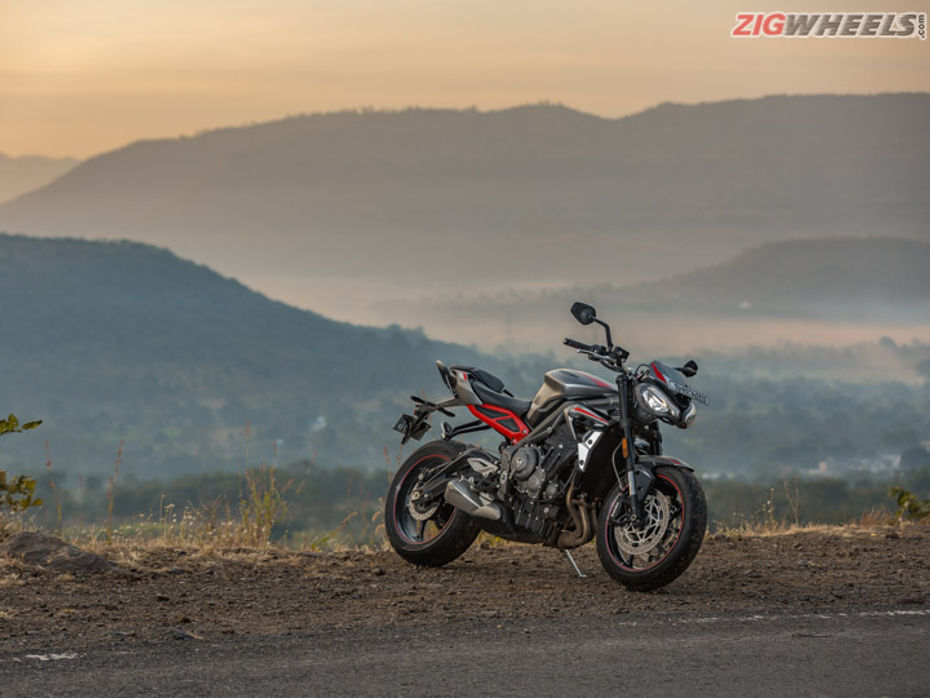
The Bland Bits
It is bizarre that Triumph decided to roll back in time to get the semi-digital instrument cluster for the 2020 Triple R. It feels even more astounding when you get to know that prior to the mid-life updates, the R used to come with the same colour TFT dash as the RS. The digital inset feels quite ancient and isn’t as attractive or intuitive to use as the TFT dash. There is a mode selector button on the left side switchgear to toggle through the ride modes on the fly. However, to switch off traction control, you have to come to a stop, and fiddle with the two small buttons next to the console.
Even the design of the Street Triple seems a bit aged. The LED brow on the bug eyes is a nice addition, giving it a meaner face and the red subframe cover adds to the bike’s sporty appeal. Still, when you consider that nearly all of its segment rivals make you sit up and take notice, the Triple R mostly goes unnoticed.
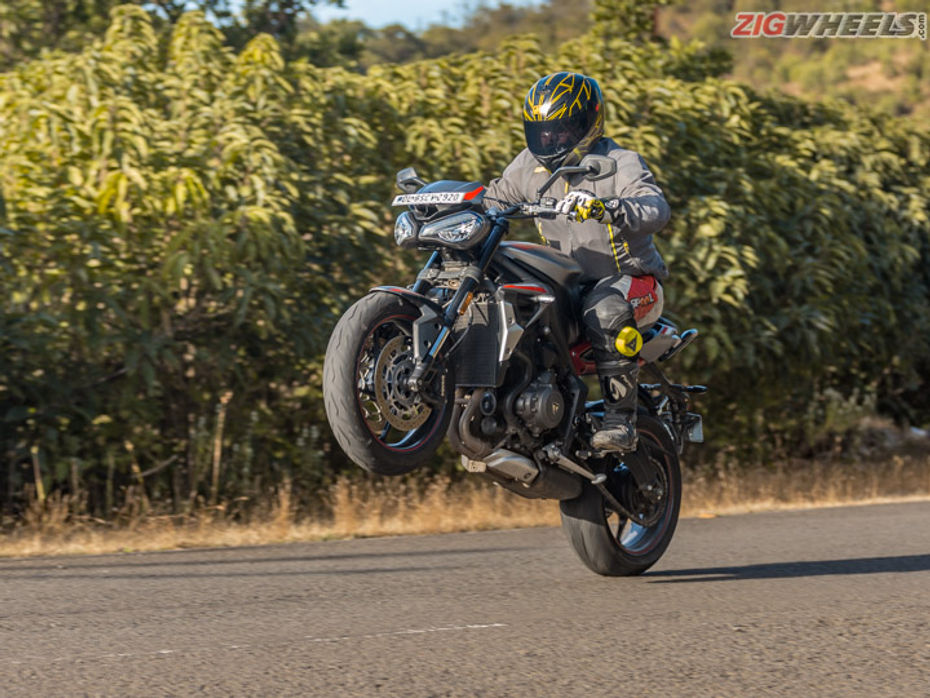
The One To Get?
Triumph India has nailed the pricing of the Street Triple R. For Rs 2.50 lakh less, you are getting nearly as much performance and kit with the R as you did on the RS. And unlike the previous entry-level Triumph roadster, the Triple S, the R scores high on delivering that fantastic handling that Street Triples are known for. In that respect, the R isn’t exactly a middleground in the series. Think of it just a notch below the RS.
There isn’t much of an emotional connection with the Triple R as you would have with a KTM 790 Duke or even the MV Agusta Brutale 800. But the Triple R’s accommodating nature makes it acceptable for riders with varying levels of skill set. The Kawasaki Z900 is more affordable, but only by Rs 65,000. For the extra money, you are getting a richer and far more rewarding riding experience and then there’s the loud exhaust note to seal the deal.
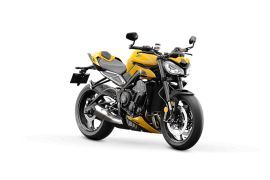

2021 Triumph Bonnies: Fiercer, Cleaner And Lighter

🏍️ 2020 Triumph Street Triples: R vs RS | Just How Different Are...

Family Feud: Triumph Street Triple R vs Triumph Street Triple RS

Touchdown! The 2020 Triumph Street Triple R Is Here
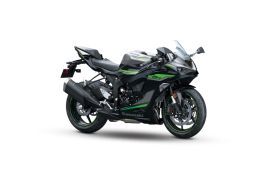 Kawasaki Ninja ZX-6R
Kawasaki Ninja ZX-6R
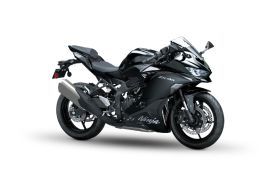 Kawasaki Ninja ZX4R
Kawasaki Ninja ZX4R
India's largest automotive community